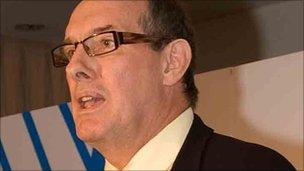Best-to-worst public sector pay link proposed by Hutton
- Published

Mr Hutton found that public sector top executives' pay had risen faster than that of other civil servants
The government's desire to limit the pay of top public sector employees has been endorsed by an independent review.
Will Hutton of the Work Foundation has said that top public servants should normally be paid no more than 20 times that of their lowest paid employees.
In May, the prime minister asked him to devise a way of ensuring the pay of the highest paid public staff was fair.
His initial report suggests that very few of them currently breach this limit.
"There is a strong case for public sector organisations having to comply with, or explain why they do not comply with, a maximum pay multiple, such as 20:1," Mr Hutton said.
"The range of top pay deals across the public sector has little coherence or relationship to the public's priorities in generating genuine public value."
Mr Hutton told the BBC that there had been a "kind of arms race" in private sector pay, and that "there is a risk that the same kind of race could happen in the public sector".
'Arms race'
The government - which initially suggested the 20:1 ratio - asked Mr Hutton to investigate the issue because of concern that the rise in top executives' pay in the public sector was unfair.
He found that in the past decade their pay had risen faster than that of their average and low earning staff - just as it had in the private sector.
There, the pay and remuneration of the most senior executives in the biggest companies has boomed spectacularly in recent years, particularly with the aid of bonuses and lucrative share options.
As a result the average pay of a chief executive of a FTSE company is now 88 times that of their lowest paid staff.
Mr Hutton pointed out that this trend inevitably had the effect of driving up the top pay of public bodies which sought to recruit executives from the private sector.
"In parts of the public sector that have more autonomy - such as universities, foundation trusts and arms length bodies in general - there are significant upward pressures on senior pay and, before the pay freeze, some increasingly eye-catching settlements," Mr Hutton said.
"The trends are there for all to see," he told the BBC.
And he pointed out that some of these pay deals might be "irrational" and have no bearing on the ability of the organisations to serve the public.
'Fairness'
Tony Travers, a professor in government at the London School of Economics, said the pay of very few public servants exceeded the 20:1 ratio.
"That would not affect most of the NHS, most of local government, [and] most other organisations that are covered by it."
"There are a small number of highly paid public sector managers who are earning much more than a 20:1 ratio but the numbers in that bracket are tiny," he added.
Dave Prentis, general secretary of Unison, the UK's largest public sector union, said that the review missed the point.
"By concentrating on the 20:1 pay ratio, that affects a miniscule 0.0001% of the public sector workforce, the report misses the elephant in the room, namely the scandal of low pay across the sector.
"The government likes to talk about fairness, but actions speak louder than words," he said.
"Public spending cuts, plus the drive to privatise local services, is depressing wages, fragmenting the workforce and undermining moves towards fairness."
'Exceptional'

Only a small minority of top earners - 20,000 out of 290,000 - work in the public sector
Mr Hutton's initial report found that in 2009, the pay of top private sector executives far outstripped that of top public servants.
Only 20,000 public servants were among the UK's 290,000 highest earners who were paid more than £117,523 a year, which put them in the top 1% of all earners.
Of these 20,000, 4,000 were managers and most of the rest were doctors and dentists in the NHS.
The average pay ratio of public sector staff just below the level of a lead executive was less than 12:1.
Mr Hutton's report says organisations should be able to pay more than the suggested 20:1 limit, but should have to justify it for those "exceptional" cases.
His final recommendations will be published in March 2011.
- Published15 September 2010
- Published13 July 2010
- Published1 July 2010